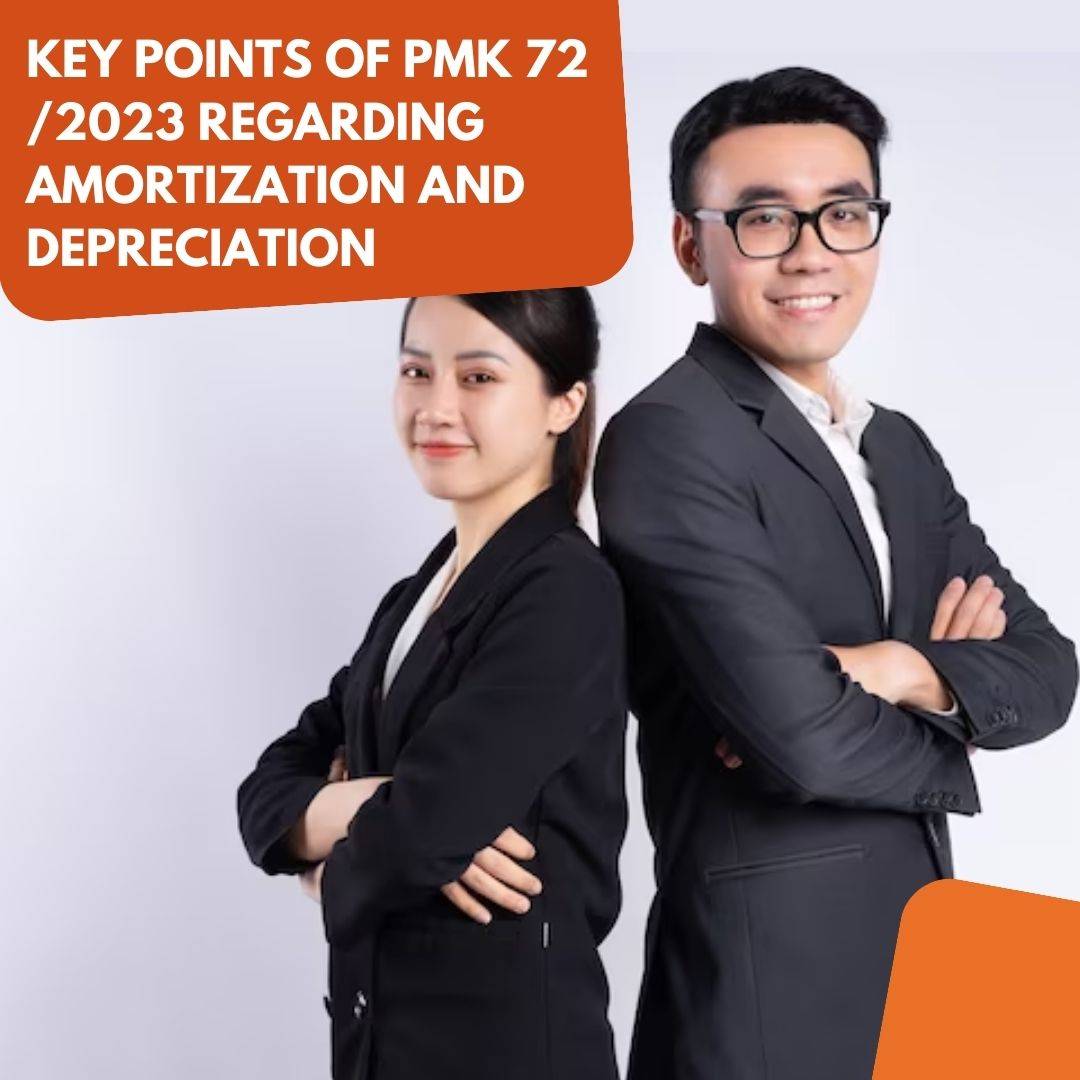6 Key Points of PMK 72 /2023 Regarding Amortization and Depreciation
On July 13th, the government enacted PMK 72/2023. This regulation, effective from July 17th, 2023, serves as the latest guidelines for calculating the depreciation rate of tangible assets and the amortization of intangible assets. The update on depreciation and amortization rules is part of the policy reform under the Income Tax (PPh) cluster of the UU HPP (Tax Regulation Harmonization Law). Through this article, TGS AU Partners will particularly provide a detailed explanation about 6 key points in PMK 72 of 2023.
Amortization and Depreciation in Taxation
In general, amortization is a procedure used to gradually reduce the value of costs by paying the principal and interest over time. It is commonly applied to expenditures to acquire intangible assets or other expenses, such as the cost of extending building or business rights, usage rights, or goodwill, which have a useful life of more than one year.
Amortization starts in the month of the sale or expenditure of the amortized asset (except for certain business sectors). If the expenditure is made in the first year and is done in the middle of the year, the calculation is done proportionally. The use of the amortization rate is based on the expenditure or the book value at the end of the amortized useful life in a single installment.

Meanwhile, depreciation is an allocation of the acquisition cost of a fixed asset (excluding land) that has a specific useful life or is adjusted according to its asset group. Depreciation can also be interpreted as one of the factors that can modify the actual cost of a fixed asset.
Depreciation usually occurs on expenses related to the purchase, establishment, addition, improvement, or alteration of tangible assets. If the expenses occur while the asset is still under construction, depreciation can only commence after the completion of the asset.
Our Service Recommendations
6 Key Points of PMK 72/2023
Basically, PMK 72/2023 is a derivative regulation of the Income Tax Law (UU HPP) and Government Regulation PP 55/2022 regarding the arrangement in the field of Income Tax (PPh). Yuli Aldyanti, SE., ACPA., BKP, as the tax partner of TGS AU Partners, hopes that this regulation can provide legal certainty in bookkeeping and tax calculation related to depreciation and amortization. Below are the 6 key points in PMK 72/2023.
Depreciation of Permanent Buildings with Useful Life More than 20 Years
If a permanent building has a useful life exceeding 20 (twenty) years, depreciation can be done in 2 ways. First, it can be done in equal parts over a 20-year useful life period, or it can be done based on the actual useful life according to the taxpayer's accounting records.
If you have already depreciated a permanent building that you owned and used before the Tax Year 2022, following the 20-year useful life, you can choose to depreciate it based on its actual useful life. To do this, you need to submit a notification to the Director-General of Taxes no later than the end of Tax Year 2022.
Now, what if you choose to depreciate based on the actual useful life but haven't submitted the notification by the end of Tax Year 2022? According to Article 6, Paragraph (4) of PMK 72 2023, you can still use that depreciation scheme by submitting the notification no later than 30 April 2024.
Provision on Depreciation for Repair Costs
Repair costs for tangible assets owned and used to generate, collect, and maintain income with a useful life of more than one year are treated through depreciation. The repair costs are added to the fiscal book value of the tangible asset.
If the repair does not extend the useful life, depreciation is done based on the remaining fiscal useful life of the tangible asset. If the repair extends the useful life, depreciation is done based on the remaining fiscal useful life plus the additional useful life due to the repair. The calculation of depreciation is done for a maximum period according to the useful life of the tangible asset category.
Insurance Replacement
The transfer or withdrawal of assets receiving insurance replacement is regulated in Article 8 of PMK 72/2023. The fiscal book value of the transferred or withdrawn asset is charged as a loss. The amount of the sales price and/or insurance replacement received is booked as income.
If the amount of the insurance replacement to be received can only be determined at a later date, the fiscal book value of the transferred asset charged as a loss is booked as an expense in the Tax Year of receiving the insurance replacement with the approval of the Director-General of Taxes. If the asset has been sold or transferred before receiving the insurance replacement, the fiscal book value of the asset charged as a loss is first calculated based on the selling price of the transferred asset.
Amortization of Intangible Assets with Useful Life More than 20 Years
Similar to the provision for permanent buildings, the recent amendment to the Income Tax Law (UU PPh) also provides flexibility for taxpayers with intangible assets with a useful life of more than 20 years to perform amortization using two methods. The first method is by using the 4th category rate, which is 5% using the straight-line method and 10% using the declining balance method.
The second method is to perform amortization based on the actual useful life. To implement the second method, taxpayers must submit a notice of the use of the actual useful life to the Director-General of Taxes no later than April 30, 2024.
News & Articles Recommendations.
Rules on Software Amortization
PMK 72/2023 divides software into two categories: specialized application programs and general application programs. Specialized application programs are programs specifically designed for the automation of administrative systems or specific work or business activities. Amortization for specialized application programs is done over a 4-year useful life.
On the other hand, general application programs are programs used by general users to process various tasks with computers. The cost of general application programs is recognized as routine operational expenses charged in one go in the relevant year.
Depreciation and Amortization Regulations for Specific Business Sectors
Previously, the depreciation and amortization for assets owned by specific business sectors were regulated in PMK No. 249/2008. Under PMK 72/2023, the specific business sectors include forestry, plantation of hardwood plants, and livestock farming.
Biological assets are classified into two categories, plants/animals that only produce results after being planted/cultivated for more than 1 year and plants/animals that have produced results within or up to 1 year of planting/cultivation.
Depreciation is performed over 4 years (forestry and plantation of hardwood plants) or 2 years (livestock farming) for plants/animals that produce results after more than 1 year. For livestock that produces results within 1 year, it can be charged in one go or up to 4 years.
Conclusion
In conclusion, PMK 72/2023 represents an update to the depreciation and amortization rules as part of the policy reform under the Income Tax (PPh) cluster of the UU HPP (Tax Regulation Harmonization Law). The regulation includes 6 key points that provide legal certainty, fairness, and ease of calculating the depreciation of tangible assets and the amortization of intangible assets for tax purposes. Understanding these key points will facilitate tax reporting and financial statement preparation for business entities and activities.
News & Articles Recommendations.





